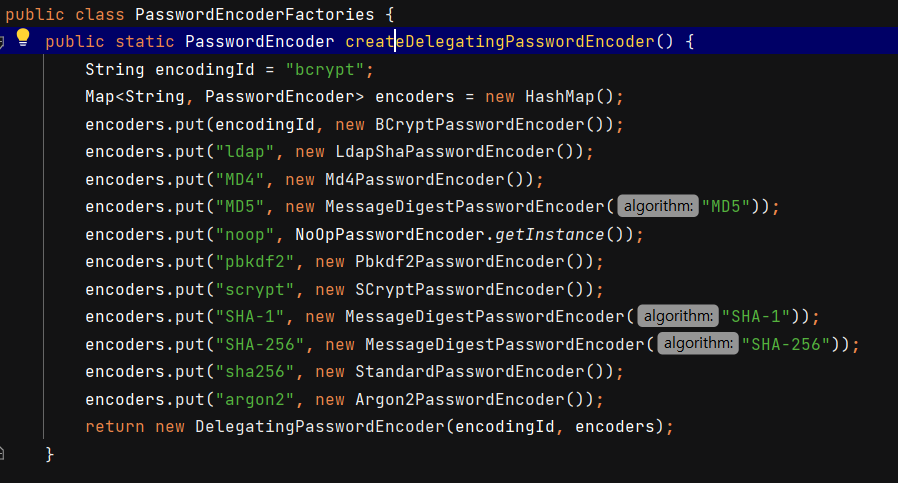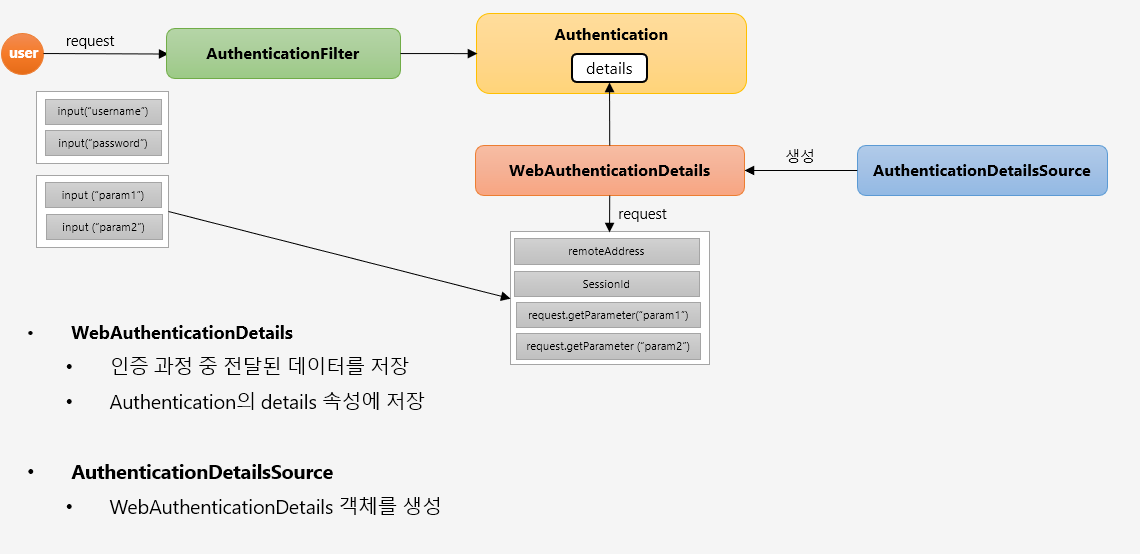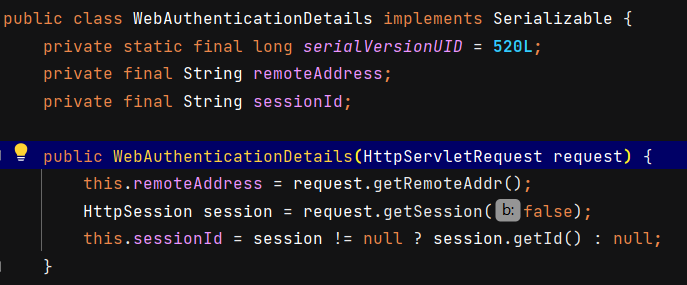- [Spring Security] Section 1. 스프링 시큐리티 기본 API 및 Filter
- [Spring Security] Section 2. 주요 아키텍처 이해
- [Spring Security] Section 3. 인증 프로세스 Form 인증 구현
- [Spring Security] Section 4. Ajax 인증 구현
- [Spring Security] Section 5. 인가 프로세스 DB 연동 웹계층
- [Spring Security] Section 6. Method 기반 DB 연동
[Spring Security] Section 3. 인증 프로세스 Form 인증 구현
WebIgnore 설정
js / css / image 파일 등 보안 필터를 적용할 필요가 없는 리소스를 설정할 수 있습니다. 다음과 같이 설정할 수 있습니다.
@Configuration
@EnableWebSecurity
public class SecurityConfig extends WebSecurityConfigurerAdapter {
...
@Override
public void configure(WebSecurity web) throws Exception {
web.ignoring().requestMatchers(PathRequest.toStaticResources().atCommonLocations());
}
}
web.ignoring() 을 설정하면 아예 보안필터를 거치지 않습니다. 반면 antMatchers("/","/users").permitAll() 이라고 설정하면 모든 접근을 허용하지만 보안필터 자체는 거쳐야 합니다.
PasswordEncoder
비밀번호를 안전하게 암호화하도록 제공합니다. 생성은 PasswordEncoder passwordEncoder = PasswordEncoderFactories.createDelegatingPasswordEncoder() 으로 생성합니다.
PasswordEncoderFactories 는 아래와 같이 여러가지 다양한 알고리즘을 지원합니다.

암호화 포맷은 {id}encodedPassword 가 됩니다. 암호화의 기본 포맷은 bcrypt 입니다. ({bcrypt}$2a$10$dXJ3SW6G7P50lGmMkkmwe.20cQQubK3.HZWzG3YB1tlRy.fqvM/BG)
코드 레벨
회원가입 등으로 User 를 만들 때 아래와 같이 passwordEncoder 로 비밀번호를 암호화시켜줘야 합니다. passwordEncoder 는 SecurityConfig 에서 빈으로 등록했으니 스프링 컨테이너에서 DI 해줍니다.
@Controller
public class UserController {
@Autowired
private UserService userService;
@Autowired
private PasswordEncoder passwordEncoder;
...
@PostMapping("/users")
public String createUser(AccountDto accountDto){
ModelMapper modelMapper = new ModelMapper();
Account account = modelMapper.map(accountDto, Account.class);
account.setPassword(passwordEncoder.encode(account.getPassword()));
userService.createUser(account);
return "redirect:/";
}
}
account.setPassword(passwordEncoder.encode(account.getPassword())); 로 인코딩한 후 userService.createUser() 메서드로 저장합니다.
CustomUserDetailService
UserDetailsService 를 직접 구현해서 Authentication 에 들어가는 UserDetails 를 만들 수 있습니다. 이를 위해 먼저 UserDetails 를 구현하는 AccountContext 클래스를 직접 만들어줍니다.
public class AccountContext extends User {
private final Account account;
public AccountContext(Account account, Collection<? extends GrantedAuthority> authorities) {
super(account.getUsername(), account.getPassword(), authorities);
this.account = account;
}
public Account getAccount() {
return account;
}
}
User 클래스는 UserDetails 를 구현하고 있습니다. account 에도 접근할 수 있도록 필드로 선언합니다.
이제 CustomeUserDetailsService 를 작성합니다.
@RequiredArgsConstructor
public class CustomeUserDetailsService implements UserDetailsService {
private final UserRepository userRepository;
@Override
public UserDetails loadUserByUsername(String username) throws UsernameNotFoundException {
Account account = userRepository.findByUsername(username);
if(account == null){
throw new UsernameNotFoundException("UsernameNotFoundException");
}
List<GrantedAuthority> roles = new ArrayList<>();
roles.add(new SimpleGrantedAuthority(account.getRole()));
AccountContext accountContext = new AccountContext(account, roles);
return accountContext;
}
}
기존에 만들어둔 클래스인 AccountContext 를 반환합니다. 이제 인증 객체에 UserDetails 에는 AccountContext 가 담깁니다.
마지막으로 빈 등록을 합니다.
@Configuration
@EnableWebSecurity
@Slf4j
@RequiredArgsConstructor
public class SecurityConfig extends WebSecurityConfigurerAdapter {
private final UserDetailsService userDetailsService;
@Override
protected void configure(AuthenticationManagerBuilder auth) throws Exception {
auth.userDetailsService(userDetailsService);
}
}
이제 해당 CustomeUserDetailsService 로 인증을 하므로, DB 에서 정보를 조회해서 Authentication 을 만듭니다.
CustomAuthenticationProvider
이번엔 인증을 직접 검증하는 AuthenticationProvider 을 구현해보겠습니다.
@RequiredArgsConstructor
public class CustomAuthenticationProvider implements AuthenticationProvider {
private final UserDetailsService userDetailsService;
private final PasswordEncoder passwordEncoder;
@Override
public Authentication authenticate(Authentication authentication) throws AuthenticationException {
String username = authentication.getName();
String password = (String) authentication.getCredentials();
AccountContext accountContext = (AccountContext) userDetailsService.loadUserByUsername(username);
if(!passwordEncoder.matches(password, accountContext.getAccount().getPassword())){
throw new BadCredentialsException("BadCredentialsException");
}
UsernamePasswordAuthenticationToken authenticationToken
= new UsernamePasswordAuthenticationToken(
accountContext.getAccount(),
null,
accountContext.getAuthorities()
);
return authenticationToken;
}
@Override
public boolean supports(Class<?> authentication) {
return UsernamePasswordAuthenticationToken.class.isAssignableFrom(authentication);
}
}
authenticate() 메서드는 내부에서 검증 작업을 실시합니다. supports() 메서드는 어떤 Authentication 이 어떤 Provider 를 사용하는지 여부를 확인합니다.
이제 SecurityConfig 에서 AuthenticationManagerBuilder에 등록해줍니다. userDetailsService 는 따로 등록할 필요가 없어지는데, 해당 클래스는 CustomAuthenticationProvider 내부에만 있으면 되기 때문입니다.
@Configuration
@EnableWebSecurity
@Slf4j
@RequiredArgsConstructor
public class SecurityConfig extends WebSecurityConfigurerAdapter {
private final UserDetailsService userDetailsService;
@Override
protected void configure(AuthenticationManagerBuilder auth) throws Exception {
// auth.userDetailsService(userDetailsService); // 아래 로직에서 다 포함
auth.authenticationProvider(authenticationProvider());
}
@Bean
public AuthenticationProvider authenticationProvider() {
return new CustomAuthenticationProvider(userDetailsService, passwordEncoder());
}
...
}
로그아웃 및 화면 보안 처리
로그아웃은 Form 태그를 이용하여 POST 로 요청할 수도 있지만 태그를 이용해 GET 으로 요청할 수도 있습니다. GET 으로 요청하면 LogoutFilter 는 동작하지 않고, 직접 API 를 작성해야 합니다.
@Controller
public class LoginController {
@GetMapping("logout")
public String logout(HttpServletRequest request, HttpServletResponse response) {
Authentication authentication = SecurityContextHolder.getContext().getAuthentication();
if(authentication != null){
new SecurityContextLogoutHandler().logout(request, response, authentication);
}
return "redirect:/login";
}
}
SecurityContextLogoutHandler 클래스에서 logout() 메서드를 통해 인증 정보를 삭제합니다.
인증 부가 기능 - WebAuthenticationDetails, AuthenticationDetailSource
인증정보에 대한 부가적인 정보 (파라미터 값 등) 을 저장하는 방법입니다.

Authentication 의 detail 필드는 Object 타입입니다. 여기서 WebAuthenticationDetails 가 들어오는데, 해당 클래스는 AuthenticationDetailsSource 클래스가 만듭니다. Request 정보를 통해서 부가 정보를 넣습니다.
WebAuthenticationDetails 클래스를 보겠습니다.

HttpServletRequest 를 받아서 기본적으로 remoteAddress 와 sessionId 를 넣어주고 있습니다.
Custom 만들기
생성
먼저 Custom 으로 FormWebAuthenticationDetails 클래스를 만듭니다.
public class FormWebAuthenticationDetails extends WebAuthenticationDetails {
private String secretKey;
public FormWebAuthenticationDetails(HttpServletRequest request) {
super(request);
secretKey = request.getParameter("secret_key");
}
public String getSecretKey() {
return secretKey;
}
}
그리고 해당 클래스를 생성해주는 FormAuthenticationDetailsSource 를 만들고 컴포넌트로 등록합니다.
@Component
public class FormAuthenticationDetailsSource implements AuthenticationDetailsSource<HttpServletRequest, WebAuthenticationDetails> {
@Override
public WebAuthenticationDetails buildDetails(HttpServletRequest request) {
return new FormWebAuthenticationDetails(request);
}
}
이제 설정파일에서 formLogin() 에 .authenticationDetailsSource() 를 등록합니다.
@Configuration
@EnableWebSecurity
@Slf4j
@RequiredArgsConstructor
public class SecurityConfig extends WebSecurityConfigurerAdapter {
private final UserDetailsService userDetailsService;
private final AuthenticationDetailsSource authenticationDetailsSource;
...
@Override
protected void configure(final HttpSecurity http) throws Exception {
http
.authorizeRequests()
.antMatchers("/","/users").permitAll()
.antMatchers("/mypage").hasRole("USER")
.antMatchers("/messages").hasRole("MANAGER")
.antMatchers("/config").hasRole("ADMIN")
.anyRequest().authenticated()
.and()
.formLogin()
.loginPage("/login")
.loginProcessingUrl("/login_proc")
.authenticationDetailsSource(authenticationDetailsSource) //등록
.defaultSuccessUrl("/")
.permitAll()
;
}
}
사용
예를 들어서, details.getSecretKey() 도 함께 AuthenticationProvider 에서 검증한다고 해보겠습니다. 이전에 만든 CustomAuthenticationProvider 에서 해당 로직을 넣어줍니다.
@RequiredArgsConstructor
public class CustomAuthenticationProvider implements AuthenticationProvider {
private final UserDetailsService userDetailsService;
private final PasswordEncoder passwordEncoder;
@Override
public Authentication authenticate(Authentication authentication) throws AuthenticationException {
String username = authentication.getName();
String password = (String) authentication.getCredentials();
AccountContext accountContext = (AccountContext) userDetailsService.loadUserByUsername(username);
if(!passwordEncoder.matches(password, accountContext.getAccount().getPassword())){
throw new BadCredentialsException("BadCredentialsException");
}
FormWebAuthenticationDetails details = (FormWebAuthenticationDetails) authentication.getDetails(); //details 추출
String secretKey = details.getSecretKey(); //secretKey 추출
if(!"secret".equals(secretKey)){ //검증 단계
throw new InsufficientAuthenticationException("InsufficientAuthenticationException");
}
UsernamePasswordAuthenticationToken authenticationToken
= new UsernamePasswordAuthenticationToken(
accountContext.getAccount(),
null,
accountContext.getAuthorities()
);
return authenticationToken;
}
@Override
public boolean supports(Class<?> authentication) {
return UsernamePasswordAuthenticationToken.class.isAssignableFrom(authentication);
}
}
details 에서 secretKey 를 꺼내서 검증하는 로직입니다. 중간 주석을 보면 됩니다.
CustomAuthenticationSuccessHandler
인증 성공 시 실행되는 AuthenticationSuccessHandler 를 만들어보겠습니다.
@Component
public class CustomAuthenticationSuccessHandler extends SimpleUrlAuthenticationSuccessHandler {
private RequestCache requestCache = new HttpSessionRequestCache();
private RedirectStrategy redirectStrategy = new DefaultRedirectStrategy();
@Override
public void onAuthenticationSuccess(HttpServletRequest request, HttpServletResponse response, Authentication authentication) throws IOException, ServletException {
setDefaultTargetUrl("/");
//인증 성공 전 요청 정보
SavedRequest savedRequest = requestCache.getRequest(request, response);
if(savedRequest != null){
//인증 성공 후 이동할 페이지
String targetUrl = savedRequest.getRedirectUrl();
redirectStrategy.sendRedirect(request, response, targetUrl);
}else {
//인증 성공 전 요청 정보가 없을 경우
redirectStrategy.sendRedirect(request, response, "/");
}
}
}
SimpleUrlAuthenticationSuccessHandler 을 상속받습니다. 인증 성공 전 요청 정보가 있다면 해당 요청 URL 로 리다이렉트해줍니다. 해당 클래스는 @Component 로 자동 빈 등록을 해주겠습니다.
이제 설정파일에서 formLogin() 에 .successHandler() 를 등록합니다.
@Configuration
@EnableWebSecurity
@Slf4j
@RequiredArgsConstructor
public class SecurityConfig extends WebSecurityConfigurerAdapter {
private final UserDetailsService userDetailsService;
private final AuthenticationDetailsSource authenticationDetailsSource;
private final AuthenticationSuccessHandler authenticationSuccessHandler;
...
@Override
protected void configure(final HttpSecurity http) throws Exception {
CharacterEncodingFilter filter = new CharacterEncodingFilter();
http
.authorizeRequests()
.antMatchers("/","/users").permitAll()
.antMatchers("/mypage").hasRole("USER")
.antMatchers("/messages").hasRole("MANAGER")
.antMatchers("/config").hasRole("ADMIN")
.anyRequest().authenticated()
.and()
.formLogin()
.loginPage("/login")
.loginProcessingUrl("/login_proc")
.authenticationDetailsSource(authenticationDetailsSource)
.defaultSuccessUrl("/")
.successHandler(authenticationSuccessHandler) //추가
.permitAll()
;
}
}
formLogin() 에 메서드 체이닝으로 .successHandler(authenticationSuccessHandler) 를 추가해줍니다.
CustomAuthenticationFailureHandler
이번에는 인증 실패 시 실행되는 AuthenticationFailureHandler 를 만들어보겠습니다. 동작 원리는 CustomAuthenticationSuccessHandler 와 똑같습니다.
먼저 CustomAuthenticationFailureHandler 를 만듭니다. SimpleUrlAuthenticationFailureHandler 를 상속받습니다.
@Component
public class CustomAuthenticationFailureHandler extends SimpleUrlAuthenticationFailureHandler {
@Override
public void onAuthenticationFailure(HttpServletRequest request, HttpServletResponse response, AuthenticationException exception) throws IOException, ServletException {
String errorMessage = "Invalid Username or Password";
if(exception instanceof BadCredentialsException){
errorMessage = "Invalid Username or Password";
}else if(exception instanceof InsufficientAuthenticationException){
errorMessage = "Invalid Secret Key";
}
setDefaultFailureUrl("/login?error=true&exception=" + errorMessage);
super.onAuthenticationFailure(request, response, exception);
}
}
exception 에 따라 errorMessage 를 다르게 하고, setDefaultFailureUrl() 로 Default URL 을 지정합니다. 이 때 query parameter 를 주면서 메세지를 표시할 수 있도록 합니다.
이제 설정 정보에 .failureHandler(authenticationFailureHandler) 를 넣습니다. AuthenticationSuccessHandler 를 설정할 때와 똑같습니다.
@Override
protected void configure(final HttpSecurity http) throws Exception {
CharacterEncodingFilter filter = new CharacterEncodingFilter();
http
.authorizeRequests()
.antMatchers("/","/users").permitAll()
.antMatchers("/mypage").hasRole("USER")
.antMatchers("/messages").hasRole("MANAGER")
.antMatchers("/config").hasRole("ADMIN")
.anyRequest().authenticated()
.and()
.formLogin()
.loginPage("/login")
.loginProcessingUrl("/login_proc")
.authenticationDetailsSource(authenticationDetailsSource)
.defaultSuccessUrl("/")
.successHandler(authenticationSuccessHandler)
.failureHandler(authenticationFailureHandler) // 설정
.permitAll()
;
}
이제 Controller 에서 인증 실패에 대한 핸들러를 작성해보도록 하겠습니다.
@Controller
public class LoginController {
@GetMapping("/login")
public String login(@RequestParam(value = "error", required = false) String error,
@RequestParam(value = "exception", required = false) String exception,
Model model) {
model.addAttribute("error", error);
model.addAttribute("exception", exception);
return "user/login/login";
}
...
}
@RequestParam 으로 Default URL 로 던진 error 와 exception 을 받아서 model 에 넣어줍니다.
CustomAccessDeniedHandler
자원에 접근하고자 할 때 인가예외를 발생시키는 핸들러입니다.
public class CustomAccessDeniedHandler implements AccessDeniedHandler {
private String errorPage;
@Override
public void handle(HttpServletRequest request, HttpServletResponse response, AccessDeniedException e) throws IOException, ServletException {
String deniedUrl = errorPage + "?exception=" + e.getMessage();
response.sendRedirect(deniedUrl);
}
public void setErrorPage(String errorPage){
this.errorPage = errorPage;
}
}
만약 인가 예외가 발생하면 handle() 메서드가 실행되기 때문에 해당 메서드만 오버라이딩 해주겠습니다. 해당 메서드는 deniedUrl 를 만들어서 리다이렉트합니다.
다음은 설정 정보입니다.
@Configuration
@EnableWebSecurity
@Slf4j
@RequiredArgsConstructor
public class SecurityConfig extends WebSecurityConfigurerAdapter {
...
@Override
protected void configure(final HttpSecurity http) throws Exception {
CharacterEncodingFilter filter = new CharacterEncodingFilter();
http
.authorizeRequests()
.antMatchers("/","/users").permitAll()
.antMatchers("/mypage").hasRole("USER")
.antMatchers("/messages").hasRole("MANAGER")
.antMatchers("/config").hasRole("ADMIN")
.anyRequest().authenticated()
.and()
.formLogin()
.loginPage("/login")
.loginProcessingUrl("/login_proc")
.defaultSuccessUrl("/")
.authenticationDetailsSource(authenticationDetailsSource)
.successHandler(authenticationSuccessHandler)
.failureHandler(authenticationFailureHandler)
.permitAll();
http //추가
.exceptionHandling()
.accessDeniedHandler(accessDeniedHandler());
}
@Bean //빈등록
public AccessDeniedHandler accessDeniedHandler(){
CustomAccessDeniedHandler customAccessDeniedHandler = new CustomAccessDeniedHandler();
customAccessDeniedHandler.setErrorPage("/denied");
return customAccessDeniedHandler;
}
}
AccessDeniedHandler 에 ErrorPage 필드를 설정해줘야 하기 때문에 수동 빈 등록을 했습니다. .exceptionHandling() 메서드로 해당 핸들러를 추가해줍니다.
컨트롤러는 아래와 같습니다.
@GetMapping("/denied")
public String accessDenied(@RequestParam(value = "exception", required = false) String exception, Model model){
Authentication authentication = SecurityContextHolder.getContext().getAuthentication();
Account account = (Account) authentication.getPrincipal();
model.addAttribute("username", account.getUsername());
model.addAttribute("exception", exception);
return "user/login/denied";
}
/denied 에 쿼리 파라미터로 exception 을 받아서 Model 로 반환해줍니다.



댓글남기기